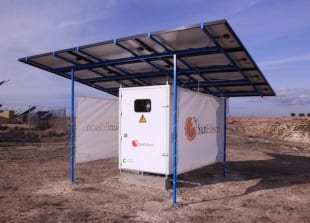 In a conference room in midtown Manhattan on Tuesday, large screens glowed bright orange with the SunEdison logo. But the gathering was not a sales pitch for SunEdison, argued the company’s CEO, Ahmad Chatila.
In a conference room in midtown Manhattan on Tuesday, large screens glowed bright orange with the SunEdison logo. But the gathering was not a sales pitch for SunEdison, argued the company’s CEO, Ahmad Chatila.
“We hope next year there will be many more companies here with us, and many more after that,” Chatila told the audience during an impromptu address.
The company was front and center, however. At the Eradication of Darkness Summit this week, SunEdison announced plans to bring electricity to 20 million people by 2020, with an interim goal of lighting up 1 million homes in 2015.
The commitment would only address a fraction of the 1.3 billion people who live without electricity and the billion others who only have intermittent access to power. But it is a considerable pledge from a single company — and a helpful boost to the World Bank’s goal of getting 500 million people connected to power through private business investments.
The timing is critical. “If we continue electrification at the rate we are going today in Africa, there will be more people without electricity by the end of the decade than there are now,” said Anita George, senior director of energy and extractives for the World Bank.
SunEdison’s social innovations team is spearheading the projects, which range from solar pumps to solar-powered microstations to clean energy for telecom towers. Although some grants are involved, most of the projects involve new financing methods that are tailored to the communities where they will be used.
In India, SunEdison has a number of partners. Working with the Art of Living Foundation, the company expects to reach 100 remote villages this year. It has also partnered with OMC Power, which builds micro power stations for rural telecoms and villages. In India, powering a telecom tower with renewable energy is an increasingly popular method for lighting surrounding villages.
“We stack LED lanterns on the back of a motor bike like a Domino’s pizza guy,” said Rohit Chandra, co-founder of OMC Power. Instead of villagers paying for a kerosene lantern, they pay about the same price for an LED lantern that is replaced daily by OMC Power.
Because the telecom is the anchor for the project, the companies can bank the project using a hybrid power-purchase agreement, even though villagers may have little or no credit. The batteries for the lanterns are recharged by the same power source that fuels the telecom tower, which are beginning to be switched to renewable power because of government mandates in India.
For other communities, SunEdison is bringing a more direct solution. Somewhere between a set of solar panels and a full microgrid is SunEdison’s microstation. The microstation is a solar panel atop a cabinet that houses a battery and power components. Depending on the number of units, it can be connected to a single-phase or three-phase configuration. It does not require any skilled labor to install and goes up in four to six hours. It can be integrated into a larger grid or also work with diesel generators.
In Nepal, SunEdison is using rent-to-own loans with five- to seven-year terms in conjunction with nonprofit SunFarmer to provide solar power with batteries to remote hospitals and schools. The cost of the loan is lower than that of the diesel energy than it replaces and has a fixed price. SunFarmer is supported in part by grants from SunEdison. The partners plan to bring electricity to 7 million by 2020.
Off-grid solutions are critical in many remote areas, but for a large portion of those living in energy poverty, the grid is nearby. Anita George said that half of the people without power in Southeast Asia and one-third of those in Sub-Saharan Africa live in places where the electric grid exists. “There will be an inflection point where off-grid [models] are the form of grid extension that is affordable,” she said.
That inflection point has already arrived in many regions, especially where clean energy solutions or access to the grid takes the place of dirty, and usually expensive, diesel generators and kerosene lanterns.
Both George and others pointed to lessons learned in previous projects. Elizabeth Littlefield, CEO of the U.S. government’s Overseas Private Investment Corporation, said that it wasn’t about just throwing money around, but rather about having the right type of capital at the right time, and bringing together various financial products to see projects from the earliest stages through completion.
Most importantly, “culture matters even more than technology,” she said. Littlefield pointed to the failure of the much-celebrated PlayPump as an example where the technology could only solve the issue in certain areas. Further, the targeted communities often were not involved in the roll-out process.
For SunEdison and the other corporations joining the mission to end energy poverty, it’s vitally important to offer a full suite of different financing methods tailored to each targeted region. In many cases, it will also mean working to augment and complement access to the existing grid, which may be a more economic option than building a standalone solution.
Source: Greentech Media. Reproduced with permission.








